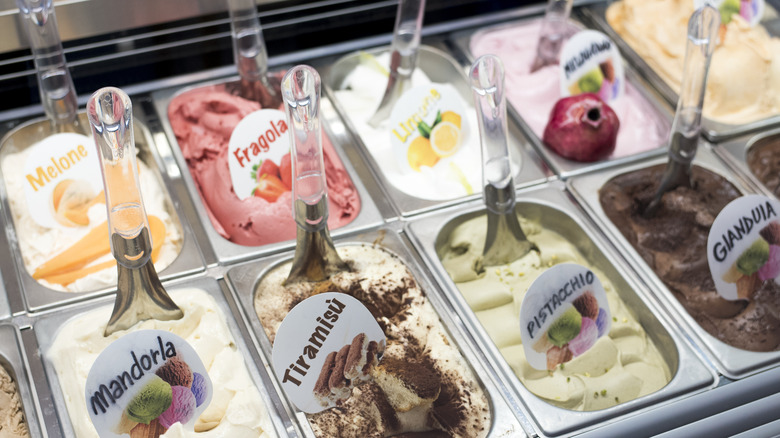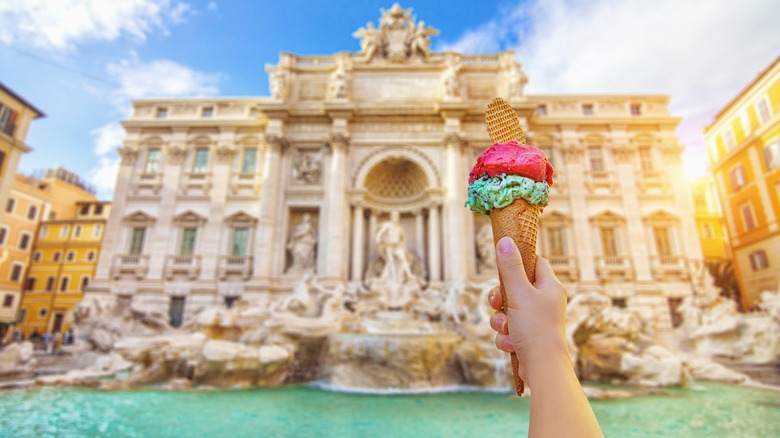The Origins Of Gelato Date Back Longer Than You Might Expect
The word gelato, meaning "ice cream" in Italian, originally comes from the Latin word for frozen. But the temperature at which it is served is one of the least interesting things about this complex, centuries-old treat.
Gelato has ⅔ less butterfat than ice cream, yet boasts a denser thickness due to the fact that it is slow-churned rather than whipped. As a result, the creamy treat cascades into waves, mountains, and intoxicating ripples behind the glass display cases at the gelato shop. Indeed, gelato's long and (literally) colorful history is characterized by a dedication to craftsmanship. "Artigianale" (or artisanal) gelato was inspired by the European Slow Food Movement, a reaction to the increasing popularity of fast food in the 1980s. A product made with artificial colors or stabilizers, argue purists, is not gelato at all. Powders, freeze-dried mixes, and concentrates don't make the cut. Many gelato makers today maintain this piety to high-quality, in-season ingredients, like locally purchased produce, hand-roasted nuts, and milk and eggs from small farms.
Near Bologna, Anzola dell'Emilia is the home of Gelato Museum Carpigiani, a space dedicated to this beloved treat's history. "It took centuries to get to the sublime perfection of this product," Luciana Polliotti, the museum's curator, told Italy Magazine. "The museum is important because it gives a cultural identity to [gelato makers] and to everybody who loves gelato." Seems like a lot of hype? It is — and it's well-deserved. This rich treat has a rich history.
Sweet beginnings
In their earliest forms, frozen treats date back to 3000 B.C.E., when people in what is now Asia enjoyed crushed ice with sweet flavorings. Ancient Romans ate the volcanic ice of Etna and Vesuvius covered in honey. Egyptian pharaohs chowed down on similar sweet and icy primordial gelato-esque desserts. It's even fabled that Marco Polo brought a gelato recipe from China back to Italy in the late 1200s. And many historians credit the invention of modern day gelato to Florence native Bernardo Buontalenti, who served it to the court of Catherine de' Medici in 1565. (Prominent American gelato brand Talenti is named after the guy.) Buontalenti's dessert was an herbaceous treat flavored with milk, egg yolks, honey, sweet wine, bergamot, lemon, and orange.
Gelato as most foodies think of it today hit the market in 1694. Esteemed Sicilian restaurateur Francesco Procopio dei Coltelli opened Le Procope in Paris (where it remains the oldest operational cafe in the city today) and put gelato on the menu. Prior to the cafe's opening, gelato was considered an exclusive luxury for the rich alone, as salt and ice were pricey. Procopio dei Coltelli brought gelato out of the private homes of the upper class and royalty, and made it accessible to consumers of all walks of life.
How gelato has evolved into the present
Gelato found its first U.S. fanbase around 1770 when Italian native Giovanni Biasiolo began peddling it in New York, but the hand-crank freezer soon allowed ice cream to overshadow the original milk-and-eggs beauty. It wasn't until the 1900s that gelato reemerged and made its lasting debut in the States. Across the ocean in Rome, the 1920s saw the advent of the mobile gelato cart. Suddenly, fashionable metropolitan foodies could be spotted strolling the stone-paved streets with a cone of the sweet stuff in hand. (Talk about killer advertising.)
Today, gelato's connection to cute corner bistros remains as modern foodies flock to dedicated gelato joints across NYC, Rome, and the rest of the world. Italy is home to roughly 37,000 gelaterias, the highest concentration of gelato parlors in the world. (Germany has 8,000 and Argentina around 3,000.) Gelateria chain GROM by Federico Grom and Guido Martinetti dominates the scene, spanning 34 Italian cities and perpetuating the Slow Food Movement even in the fast-paced present.
Sit-down spots like these aren't the only way people dig it, either. Countless gelato brands line grocery store freezer aisles for take-home enjoyment, putting this Italian specialty in the ranks right beside ice cream for both pleasure and accessibility. Gelato can be enjoyed on top of a pastry for breakfast as brioche con gelato, or use it to make a killer affogato after dinner. Modern fans often add toppings like chocolate chips, waffle cone chunks, or even an entire cannoli.


